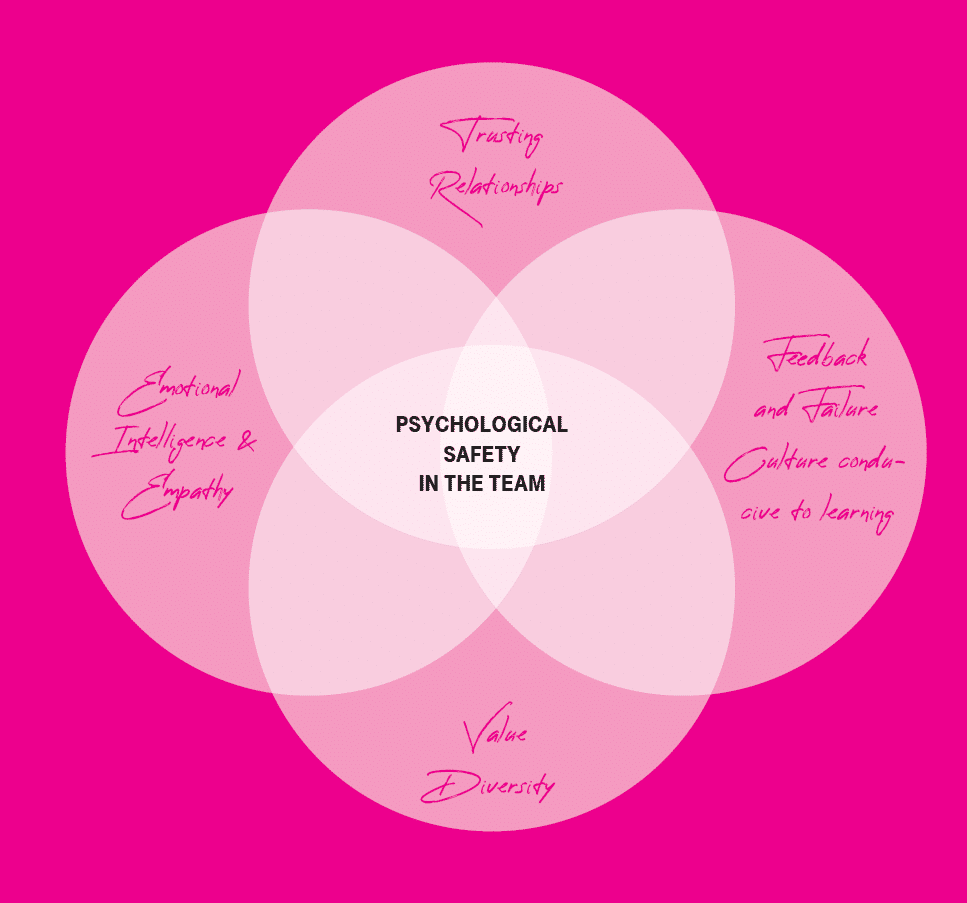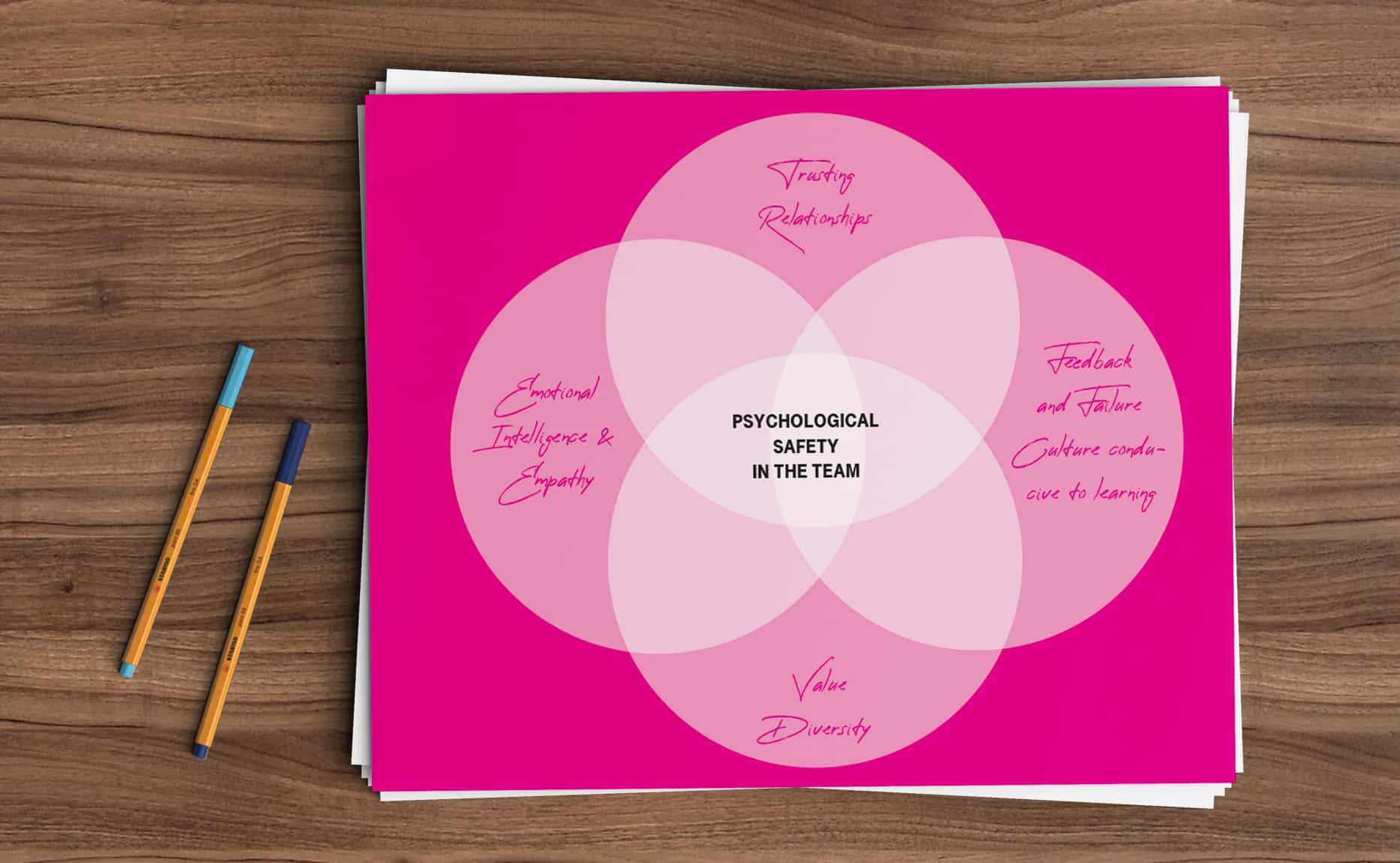CONFIDENCE AND PSYCHOLOGICAL SAFETY – Part 2.
Whether team members feel psychologically safe has a strong impact on the team’s performance, as it forms the basis for innovation, motivation, commitment and creativity.
- Part 1: Trust
- Part 2: Psychological safety
- Part 3: Team performance
Part 2: Psychological safety
What is psychological safety?
Psychological safety is a state in which opinions and ideas can be exchanged without blame or hostility.
The idea of psychological safety goes back to the Harvard behavioral scientist Amy Edmondson.
She defined “psychological safety in a team” as “a shared belief among team members that the team is safe to take interpersonal risks”.
Creating psychological safety is teamwork.
Everyone contributes to a fear-free atmosphere and constructive and respectful cooperation.
And thus contributes to well-being in everyday working life, less stress and better health – both at work and in private life.
A psychologically safe environment does not happen by itself.
Nor does it happen overnight.
But: together you can build a culture of trust in the team in which all team members can express their opinions openly without fear of negative consequences.
The more psychological security, the better teams or individual employees can cope with difficult tasks.
This is because an atmosphere in which everyone’s thoughts and actions are valued promotes commitment and a spirit of innovation as well as learning and further development within the team.
And thus increases effectiveness.
Psychological safety in the team means that everyone can express their opinion openly and without hesitation.
All team members have the opportunity to have their say in equal measure, i.e. different perspectives are taken into account regardless of status.
In a team with psychological safety, there is an atmosphere characterized by social empathy and mutual understanding.
Psychological safety promotes solution-oriented thinking, as it becomes possible to learn from mistakes instead of looking for someone to blame.
And everyone in the team is valued for their individual strengths and recognized as a whole person with their strengths and weaknesses.
But what is the difference between psychological safety and trust?
Trust is an elementary component of psychological safety in teams.
It can only be developed through trusting relationships between team members.

Another important prerequisite for psychological safety is emotional intelligence and empathy.
There is of course an interaction between these two aspects – trust and empathy – because without empathy it is difficult to build trust.
Emotional intelligence means that I can perceive my own emotions and the emotions of others, regulate my own emotions and react to the emotions of others.
An important skill that increases emotional intelligence in a team is recognizing and articulating emotions.
Emotional granularity, including a broad emotional vocabulary, can be well practiced and deepened in team check-ins.
Psychological safety in teams is characterized by a feedback and error culture that promotes learning.
Here, too, there is an interaction with trusting relationships, as trust is an important basis for innovation and creativity.
In sociology, this is referred to as an investment strategy, i.e. trust is the only way to make the investment in the relationship worthwhile by contributing creative and innovative ideas.
Another pillar of psychological safety in teams is the appreciation of diversity, i.e. the recognition and appreciation of differences in the team.
This includes considering different perspectives (cognitive diversity) and tolerating differences of opinion.
In reality, embracing diversity is not easy.
What is it not?
Psychological safety is not an end in itself, but forms the basis for performance and commitment.
A team with psychological safety is not just a feel-good team.
It’s not about being nice.
If the focus is only on well-being, psychological safety is misunderstood and we have a pseudo-psychological safety.
Pseudo-psychological teams are a risk because members don’t have the courage to point out mistakes to each other.
History is replete with examples of how this has led to disasters (from nuclear reactor accidents to spaceship crashes).
Psychological safety does not mean freedom from conflict, but on the contrary, a space in which conflicts and mistakes can be openly addressed without the person themselves being called into question.
An atmosphere of psychological safety also does not mean that all ideas are accepted.
The matter can be debated vigorously.
Psychological safety does not mean compromising performance standards.
On the contrary, psychological safety enables an increase in performance within the team.
“Psychological safety is not about being nice. – It’s about giving honest feedback, openly admitting mistakes and learning from each other.” [Amy Edmondson, Harvard Business School]
Trust and psychological safety are not new
Trust and psychological safety have been studied in psychology and sociology for decades.
The first approaches can be found with Warren Bennis and Edgar Schein in the sixties, with William Kahn adding further depth in the nineties.
Originally, psychological safety only referred to the individual, until Amy Edmondson examined psychological safety in the context of teams.
In the corporate context, psychological safety first gained particular attention through a Google research project (project name Aristotle – 2012).
Google investigated factors that influence the performance of teams.
In this study, psychological safety was identified as the most important basis for team performance.
Google presented its findings in a newspaper article in the New York Times in 2016, and since then psychological safety has also received a lot of attention in other companies.
Several studies have demonstrated the link between psychological safety and team performance.


